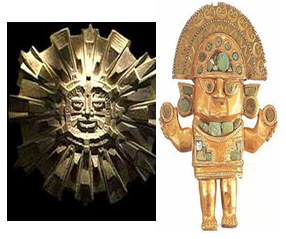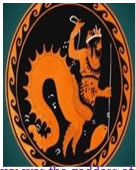- Home
- 21st Century Skills
- Which Aspects in a CLIL Class Can help Students Become Plurilingual and Pluricultural Communicators ?: An Erasmus+ Paradigm
Which Aspects in a CLIL Class Can help Students Become Plurilingual and Pluricultural Communicators ?: An Erasmus+ Paradigm

Konstantina Zavalari is an EFL teacher at Gymnasio Loutrakiou, Greece. She holds a BA in English Language and Literature from the University of Athens, Greece and an MEd in Applied Linguistics from The Open University, UK. Her research interests include CLIL, Systemic Functional Grammar and Grammar of Visual Design applications in EFL. She is currently coordinating an Erasmus+/KA229 project and has participated in eTwinning, Erasmus+ and Comenius projects.
Introduction and theoretical issues
CLIL is the acronym for Content and Language Integrated Learning, which is currently a very dynamic trend within the European educational context, particularly in the field of second/foreign language teaching. CLIL intertwines content and language in a reciprocal relationship, attributing an equal status to these components.
“In order for a programme to be defined as CLIL, students need to learn content through language and language through content rather than learn the language separately from the content”. (Llinares et al., 2012, p. 189).
Their equality is supported and enhanced by the idea of integration, which embraces these two components of CLIL and provides them with equally respective ground for development. Nikula et al. (2016) view ‘integration as a shared concern for all forms of education that have simultaneous content and language learning objectives’ (p. 1). Therefore, we could quite safely suggest that, in a CLIL class, content cannot thrive out of a linguistic environment, and that language needs content to thrive.
What’s more, CLIL develops around the reality that approaching, teaching and studying content in a second/additional or foreign language demands the employment of a series of complex cognitive synergies, which belong to the sphere of CALP (Cummins, 1979, in Llinares et al.,2012) – cognitive academic language proficiency, while class interaction also involves BICS (Cummins, 1979, in Llinares et al., 2012) – basic interpersonal communication skills. While BICS facilitate social interaction in class, content introduction and development demand more than simple social language knowledge: they demand such a linguistic competence and cognitive tools that will challenge learners’ mastery of formal registers and genres, those ones which can only be encountered in formal academic contexts, such as the school. Therefore, learners need to raise their linguistic level from the language of social, everyday interaction to the language of schooling (Schleppegrell, 2004, in Llinares et al., 2012).
This perception is directly related to the socio-cultural approach of language teaching, where students are challenged to make use not only of simple, everyday language to
negotiate meaning and facilitate communication, but also to use more complex linguistic structures, more elaborated, content-specific vocabulary, to activate previously stored school and social knowledge in a cognitively demanding procedure and to be able to communicate meaning through the interpretation of different signs, such as images.
As part of an Erasmus+/KA229 project, under the title «CLIL threads and trends in the solar-system Labyrinth», participating teachers are challenged to explore CLIL as an innovative and creative tool of teaching English as a Foreign Language to 13-15-year-old students from five (05) European countries, namely Greece (the coordinator), Portugal, Hungary, Poland and Bulgaria.
“CLIL threads and trends in the solar-system labyrinth”: a theoretical framework
This Erasmus+ project is designed to teach Astronomy and Mythology in English, connecting these subjects to their affiliated ones, namely Geography, Biology, Chemistry, Physics, History, RE and Art.
Moreover, it anticipates to develop a comprehensive linguistic model to support the design of original teaching material and methodology for the proposed CLIL classes. The proposed linguistic tool encompasses aspects of M.A.K Halliday’s Systemic Functional Grammar, Lev Vygotsky’s sociocultural theory and Gunther Kress and Theo van Leeuwen’s Grammar of Visual Design. The model views language, according to the common perception and axis of the preceding theoretical approaches, as a social product, born and developed in social contexts to serve specific social needs. It also views (verbal) language, according to Vygotsky, as one of the means that speakers have at their disposal in order to communicate (John-Steiner and Mahn, 1996), therefore it seeks other mediums and channels, through which language, and consequently communication, are produced. Such mediums can be images and other signs.
In terms of Systemic Functional Grammar (SFG), the integrated nature of content and language in a CLIL class is determined by specific, context-based, linguistic choices which are essential to support some particular kind of content, therefore, specific content demands specific language patterns to be developed.
Content/language environments are expressed, supported and developed by texts of different genres, produced by interlocutors to reach appropriate meanings in a given social context (Halliday and Matthiessen, 2014). The idea is that ‘meaning’, articulated in texts, is context-specific and context-driven and this condition dictates the interlocutors’ linguistic choices to serve the needs of the meaning they want to convey. Texts, therefore, are entities of different modes and various genres. They are also ‘signs’, which use different forms, ‘signifiers’, to realize meaning, the ‘signified’ (Kress and van Leeuwen, 2006). Written language, for example, – along with all its components - is one of the signifiers available to interlocutors to produce a signified, a written passage, in the same sense that shapes (a circle, a triangle), colour, perspective and line are signifiers used to produce an image, a drawing, - the signified which can also communicate simple or complex information instantly and effectively. It is their signifiable relationship what places texts and images in a dialectic condition, since both function as meaning mediums, either independently or complementarily.
This Erasmus+ project, therefore, investigates this intertwined relationship of written language and image language, and aims at helping students use language consciously, being aware of the social context and its communication needs in terms of vocabulary, grammatical patterns, syntax and social language.
The cultivation of this ability can take us deeper to the essence of a CLIL class. It can assist the teachers and the students interact with language in plurilingual/pluricultural terms.
Plurilingualism/Pluriculturalism : CLIL-affiliated trends
Plurilingual ability and efficiency do not only have to do with one’s linguistic competence. Being plurilingual does not only mean ‘knowing how to speak different languages’. It does not only have to do with one being fluent, accurate or efficient in more languages than one. Plurilingualism does not simply align with multilingualism and it does not just stand for an alternative to one being a ‘polyglot’. In fact, plurilingualism involves multilingualism, meaning that being plurilingual is a lot more than being multilingual. Plurilingualism has to do with one’s ability to use a language in many different contexts, serving various communicative purposes. Quoting from Coste et al. (2009):
‘Plurilingual and pluricultural competence refers to the ability to use languages for the purposes of communication and to take part in intercultural interaction, where a person, viewed as a social actor has proficiency, of varying degrees, in several languages and experience of several cultures. This is not seen as the superposition or juxtaposition of distinct competences, but rather as the existence of a complex or even composite competence on which the social actor may draw’ (p.11).
Therefore, being plurilingual means that one can recognize the social environment of communication and, according to its components, they can adjust and adapt their language. Therefore, plurilingualism is directly connected to one being socially conscious, thus making those linguistic choices which can match the societal framework. The idea of one being socially conscious in order to be an effective communicator leads to the notion of pluriculturalism, which means that one can serve different cultural needs while using a language to communicate.
In being plurilingual/pluricultural, one is capable of using various ‘signs’ to achieve communication goals in a wider sense. Therefore, an effective, plurilingual/ pluricultural communicator is conscious of the social, cultural and linguistic modes available to them, in accordance with each communication context. They can ‘read the signs’ dialectically and, in essence, they are expected to produce meaning which is context-specific and makes sense.
Aspects of using the language for social purposes in the CLIL class: our Erasmus+ methodolog
The examples below are samples and parts of the original CLIL teaching material which has been produced within the framework of this Erasmus+ project and depicts its linguistic model and methodology.
Socially-based communication serves socially-based, socially-driven needs. This means that communication mediums, one of which is language, are used to address socially-defined communication targets. The social environment, the social roles of the interlocutors and the nature of communication oblige the interlocutors to make specific lexicogrammatical choices, those proper ones of the many a language offers, - a semiotic process -, to reach very targeted communicative ends (Eggins, 2004).
If this idea is embodied in a CLIL class, what, at first glance, seems like an ordinary compare-and-contrast activity (see below –Example 1) gradually turns into a more complicated process of meaning negotiation, since other elements than the obvious ones, such as the artistic perspective (1D vs 3D), the different artistic genre (a drawing on a pot/ a sculpture), movement/lack of movement, colour, etc, demand specific vocabulary and structures to be described, therefore speakers need to move on to other choices than the obvious ones.
Such an approach, a more socially-oriented meaning negotiation, can start a social dialogue within the class, where students can argue and interact, using lots of social language, which can efficiently support the content language and make the interaction vivid and meaningful. Therefore, students do not only need to decide on the proper language that serves their needs towards meaning production (content language), they also feel that they have to adopt a holistic attitude, which has to do with their inherited social knowledge, to communicate effectively. This reality has to do with them becoming plurilingual and pluricultural.
Example 1 - Konstantina Zavalari (Gymnasio Loutrakiou, Greece)
Compare and contrast the following pictures. Talk about differences that have to do with: a. Hermes’s appearance, b. artistic elements, c. artistic context d. Hermes’s role:
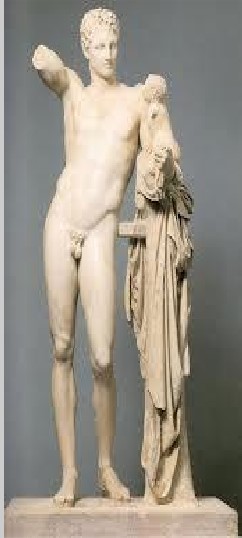
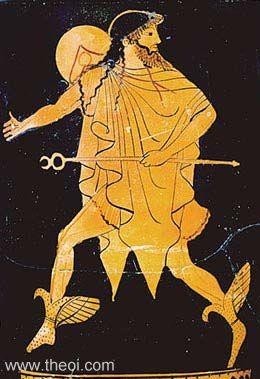
Example 2 – Konstantina Zavalari (Gymnasio Loutrakiou, Greece)
What do these companies do ?
www.hermesmail.com : You can trust us to take your letters and parcels worldwide.
www.hermesair.com : Our planes travel you to the east and the west, the fastest, the safest, the cosiest.
www.hermes-logistics.com : Our lorries are brand-new, our drivers are very experienced, your goods are safe.
www.hermesrail.com : Fast, luxurious, comfortable trains to take you anywhere a rail can. Get on board!
The activity above (Example 2) is another example of a plurilingual/pluricultural approach to language usage. It can be negotiated on two levels. Firstly, students need to decide on the content of the given websites as such. They have to start their meaning negotiation from the common aspect of “Hermes” within the name of the website and decide why it has been chosen. This negotiation requires a ‘dive’ into their previous school and social knowledge in order to reach agreement, and this process requires a significant amount of content language as well as lots of social language. Secondly, students need to deal with the text that accompanies each website and decide on a) the text genre, b) its social purpose, c) its relationship to the websites, and d) its language forms. Such an activity can also be produced by students, after they have gathered information about the core content (Hermes, the god), as their attempt to produce language and language paradigms that expand the content socially.
Example 3 - Margarida Marques, Cristina Alves, Conceição Abreu (Agrupamento de Escolas Miguel Torga, Bragança, Portugal)
Below you have 10 gods or goddesses that represent the Sun.
1) Do you know any of them? If yes, which one do you know? How do you know it?
2) Why do you think people worshipped the Sun?
Lugh Shamash Hitzilopochtli
Di Jun THE SUN Kinich-ahau
Amaterasu Indi
Lisa Malina Surya
The activity above is a guessing game. Guessing games are a very good example of starting a plurilingual/pluricultural interaction because there are many issues to be negotiated and lots of social language on demand. Moreover, in order to reach conclusions and/or agreement, interlocutors need to make use of stored social knowledge, which they cannot avoid sharing with each other, thus benefiting from the others’ input. Linguistic choices, such as structures to express probability and suggestion (the usage of modal verbs, for example), structures of arguing, contrasting and reasoning, conditional structures, are on the first level of demand and choice for the interlocutors to communicate effectively and make meaning.
The activity develops below, by providing the students with additional information concerning the previously introduced content. Now they are given more to negotiate and complete the puzzle. Simple passive forms can be a central linguistic choice with this new piece of information.
These are the countries or civilizations where the gods above were worshipped:
Peru (Inca) - INTI
Mexico (Azteca) - HITZILOPOCHTLI
Europe (Celtic) - LUGH
Yacatan Peninsula (Maya) – KINICH-AHAU
China (Taoist) – DI-JUN
West Africa (Fon) – LIZA
Japan (Shinto) – AMATERAZU
Greenland (Inuit) – MALINA
India (Hinduism) – SURYA
Western Asia (Mesopotamian) – SHAMASH
Example 4 - Margarida Marques, Cristina Alves, Conceição Abreu (Agrupamento de Escolas Miguel Torga, Bragança, Portugal)
|
Apu-punchau was believed to be the ancestor of the Incas. He was at the head of the state cult, and his worship was imposed throughout the Inca empire. He was usually represented in human form, his face portrayed as a gold disk from which rays and flames extended. His sister and consort was the moon, Mama-Kilya (or Mama-Quilla), who was portrayed as a silver disk with human features. Among the 20th-century Quechua people, he is occasionally confused with Christ or God. |
|
He was the Sun god to the Fon people of West Africa. His sister was the Moon god, Mawu. The two were twins, but were also lovers. Together, they created the Universe with the help of the cosmic serpent, Da. It is said that he used his son, Gu, to shape the world. Gu was the divine tool in the shape of an iron sword. He taught the people many different crafts, including ironworking. He was also the god of heat, work and strength. Mawu was the goddess of night and motherhood, work and strength. Mawu was the goddess of night and motherhood. |
Example 4 is a sample from a larger text activity, in which elaborated texts provide information about the god and goddesses discussed in the previous activity (Example 3). Here, students have to study reports which give additional information about the already discussed content, using more elaborated and content-specific language. Moreover, core information from the texts is depicted on the images that accompany the texts. Image making is an almost innate cognitive process, taking place while reading a text. Written language is simultaneously transformed into an image and the reader simultaneously shapes, colours and frames what they read. Therefore, we could say that images are powerful communication tools and share the same linguistic
patterns and qualities with the written or spoken texts. The texts above have more elaborated content language, both in terms of vocabulary and grammatical structures, and this development could be seen as a scaffolding process: students have moved from what they already know and can utter to more complex language and information – content develops along with language and language follows the increasing content demands. The content also initiates an intercultural dialogue and students are challenged to discover and reflect on connections with other cultures and philosophical trends.
The above activity develops into an argumentative interaction below. The students have to answer questions which ask for their personal view and understanding of the issues previously presented and discussed. The subjective and affective factor of this activity makes the meaning negotiation process a more demanding one, since students do not just report, but argue. The arguing procedure includes the reported facts, but it also demands higher order thinking skills in order for the students use the reports in a combination with their personal ideas and knowledge about the issues discussed, as well as their deductions.
- Why do you think the Sun was one of the most powerful deities?
- Would you like to have lived in a time when The Sun was worshipped? Why?
- Which God did you like best? Justify your answer
Example 5 - Konstantina Zavalari (Gymnasio Loutrakiou, Greece)
The sample below is part of a larger class on the Geocentric/Heliocentric model and the celestial bodies, namely asteroids, black holes and comets. Content-specific texts (e.g What is an Asteroid ?) have introduced the subject and, after they have studied the reports, students are asked to do a number of activities, whose common feature is creativity and originality. It has been proven from class practice that it takes more than content comprehension and knowledge to do the activities – it mostly takes social knowledge and pluricultural skills.

“Asteroids are small, rocky objects that orbit the Sun. Although asteroids orbit the Sun like planets, they are much smaller than planets.
There are lots of asteroids in our solar system. Most of them live in the main asteroid belt—a region between the orbits of Mars and Jupiter. Asteroids are left over from the formation of our solar system.
The objects in the asteroid belt never had the chance to be incorporated into planets. They are leftovers from that time long ago when planets formed.
- Asteroids aren’t all round, like planets. They have jagged and irregular shapes.
- Some asteroids are hundreds of miles in diameter, but many more are as small as pebbles.
- Most asteroids are made of different kinds of rocks, but some have clays or metals, such as nickel and iron.
These space rocks can give scientists lots of information about the history of planets and the sun. Scientists can learn about asteroids by studying meteorites: tiny bits of asteroids that have flown through our atmosphere and landed on Earth’s surface”
(source : https://spaceplace.nasa.gov/asteroid/en/ selected and adapted)
Activity 1
What is the word ? Give the right answers, check their first letter and you will come up with a nice (!) word:
- the movement around a celestial body
- it is deep, powerful and inescapable
- one of the most powerful objects in the universe
- he studies the power of money
- an area, a big or small amount of space
- you can see it
- a space travelling rock
- it is not only for the animals
- you cannot see it
- it is not round; it’s the shape of an egg
- that’s what could be a core
Activity 2
Can you tell what it is all about? Not very scientific, hhm?
1) Have you ever heard about these «celestivorous» space monsters?
2) This universe beauty is nothing like the Bermuda Triangle whirlpool, is it?
3) Not much of a magic broom to ride, right?
4) They have been kicked off the nutshell, that’s why they are pissed off !!
5) You do not normally call it «hair»!! Would you ever think of washing, cutting or …dyeing it?
6) These beauties are a perfect example of space recycling. See what you can manage if you start recycling?
7) What would you go for if you wanted to study space geology ?
8) What ??!!! More leftovers and kick-offs??? Hey, we cannot manage our own litter on this planet, guys! Don’t send more!
Activity 1 is about matching the proper word from the texts studied to the definition and Activity 2 is a riddle activity. Data for the activities to be done derive from the texts – like the given one here – which students have already studied. Language is used creatively and students need to think «out of the nutshell» to make sense and, consequently, to make meaning. Social knowledge walks hand in hand with content knowledge and specific language choices are made to reach conclusions and answer the riddles. Meaning negotiation skills and content specific data are simultaneously employed.
Example 6 - Éva Pató Szebényi (Bicskei Csokonai Vitez Mihaly Altalanos Iskola, Hungary)
The sample activities below are part of a larger lesson plan, which the Hungarian coordinator of this Erasmus+ project, Éva Pató Szebényi, designed and implemented during our meeting with students in Hungary in March 2019. The classes were about the creation of our solar system and the Sun, and they were characterized by their high degree of creativity and the extensive use of ICT. These sample activities can give an idea of how visual literacy can be part of verbal literacy and vice versa, showing their interconnection and adding to the hypothesis that images can be considered language entities, with structures, morphology and potential similar to written texts. Moreover, our ability to read, interpret and reflect on images goes through a mental, linguistic-like process, as said above, which is almost innate and spontaneous. Images and words, in a combination, can take meaning negotiation further than the obvious. When this negotiation takes place within a social group, plenty of social dynamics can develop towards the ultimate goal of meaning making. A result of this process can be the presentation task that Activity 4 asks for. Presentation skills require, among other things, a degree of meaning finalization, which is an example of a plurilinguistic activity. The whole lesson plan of the Hungarian participant school can be found in Appendix 1.
Activity 1
Create a mind map about the topic SUN. What words, expressions do you connect to the Sun? You can use internet and find out how a mind map look like. Be creative in your work!
Activity 2
Use online sources and look for Sun deities. Study these gods and goddess and list them to the others. Create your own SUNGOD. Draw it and explain it to the other participants. (https://en.wikipedia.org/wiki/List_of_solar_deities)
Activity 3
Use internet and find the word SUN in different languages. Create a “word cloud” with these words and present it to the others. Tell the others the reason why you have chosen such a shape for your word cloud and what languages have you used. (https://wordart.com/)
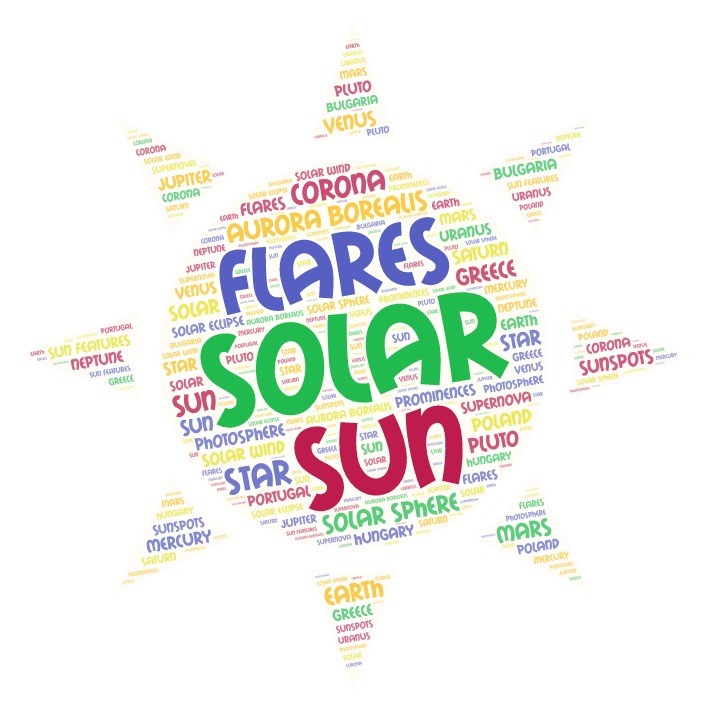
Activity 4
Create your own solar system. Imagine there is another solar system in the Milky Way. What does it look like? What is the name of its sun? How big is this star? How many planets does it  have? How big are the planets? What do they look like? Any other questions that comes to your mind. Be creative! Illustrate it and present it.
have? How big are the planets? What do they look like? Any other questions that comes to your mind. Be creative! Illustrate it and present it.
Text in an image
A word cloud can be an excellent example of the interconnection of an image and words. Both its creation and its ‘reading’ demand a series of linguistic and cultural hypotheses and deductions in order for the interlocutors –or a single speaker- to make sense of what it is about. Activity 3 challenges students with a more advanced task : not only do they need to find the word content of their word cloud, they also need to connect it with the shape of the word cloud (the visual aspect) and to explain why they have decided on that like that. This task requires lots of social knowledge and imagination to be fulfilled and gives students the opportunity to exchange them in order to negotiate meaning.
Example 7 – Anna Ewertowska (Zespol Szkol Szkola Podstawowa im.gen. Jana Henryka Dabrowskiego I Liceum, Dobrzejewice, Poland)
The sample activities below are part of a series of lessons concerning the Sun and they were devoted to Nicolaus Copernicus - the great astronomer who was born in Toruń, the Polish city where the school of this Erasmus+ project is. The students were invited to visit the Nicolaus Copernicus University. At the place, they also visited the university library to find out information about the life and heritage of Nicolaus Copernicus. They searched for books and made notes to be later translated into English with the teacher's help. After the visit in the library, they prepared a presentation using modern technology. (The activity was a combination of using traditional sources and new technologies). The teacher prepared a handout which included before, while and after presentation activities. The construction of the activity enabled students to obtain/expand knowledge concerning the topic of our project and different skills, e.g. searching, organising and analysing information, presenting information in a chronological and clear way, cooperation, critical thinking, using English for communicative purposes. These higher order thinking skills lie in the very essence of a CLIL class, thus providing students (and teachers) with a challenging interaction, which is not just a social talk, but a complicated and elaborated process towards decision and meaning making.
Activity 1
WHILE-WATCHING the presentation
Decide whether the sentences are TRUE or FALSE.
a) Nicolaus Copernicus was born in 1473 and he was an only child. ______
b) He couldn’t start his education early because his family was rich. ______
c) During his studies in Kraków, he was especially interested in astrology. ______
d) Nobody knew anything about the heliocentric theory before Copernicus. ______
e) Nicolaus Copernicus was the man of the renaissance. ______
f) Scientists found his grave in 2015. ______
Activity 2
Can you match the places with the activities Copernicus did there?
|
|
|
|
|
|
|
|
|
|
|
|
|
|
Activity 3
AFTER the presentation
In groups of four, answer the questions about Nicolaus Copernicus’ life and heritage.
Teacher cuts the questions out and puts the papers in the bag. He/She takes a draw and reads the question out to the first group. If the group knows the answer, they get a point. If not, the second group gets a chance, etc.
|
Why did Copernicus travel a lot?
|
What was Copernicus first school? |
|
What countries did Copernicus live? |
What does it mean to be “the man of the renaissance”?
|
|
What did Copernicus father sell? |
Who described the idea of gravity for the first time?
|
|
Did Copernicus have troubles at school? |
How many brothers or sisters did Copernicus have?
|
|
Can you tell three cities where Copernicus studied?
|
What was Copernicus father’s proffession? |
|
Can you tell three subjects that Copernicus studied?
|
Can you tell three places in Toruń called the Copernicus name? |
|
What is the name of the theory that Copernicus proposed?
|
Where was Nicolaus Copernicus born? |
|
Who took care of Copernicus after his father had died?
|
How old was Copernicus when he died? |
|
What did Copernicus looked like?
|
What kind of cake is produced in Toruń? |
|
Was Copernicus a priest?
|
Can you tell three achievements of Nicolaus Copernicus?
|
|
What did he write in Frombork?
|
What is Toruń famous for? |
Example 8 – Effie Athanasiadi ( French teacher , Gymnasio Loutrakiou, Greece)
The activity below is an example of how elements of everyday communication purposes, such the days of the week in English, can be referred back to as socio-cultural pieces of information, that have to do with different societal domains, such as religion and mythology. In doing this activity the students are given the chance to realize the development of human thought in a continuum and get acquainted with the reality that all the social trends have been reflected on the linguistic elements, thus linking language and thought.
Culture corner
How much do you know about the days of the week in English? I am sure you can tell them by heart ! But how did they get such names ? Well, here are some tips : study these names and try to match them to the days of the week :
|
1) The Sun god |
|
|
2) Freya, Odin’s wife, goddess of love, beauty and fate. |
|
|
3) Tyr, the Scandinavian god of war. |
|
|
4) Thor, the great Scandinavian god of thunder, Odin’s son |
|
|
5) Máni, the moon god in Norse mythology |
|
|
6) Odin, the king of gods. Also called Woden. |
|
|
7) Saturn, the great titan and father of the gods in Roman tradition. |
|
Conclusions
In this Erasmus+ project we are experimenting on elevating the level of EFL teaching from a formal, structural procedure to a functional one. We seek to incorporate “the language of schooling” and CALP into our teaching methodology. CLIL is our vehicle towards these ends. Therefore, we view language as a medium of social communication, which is not only a set of grammatical rules and syntactical structures. It is above all a vehicle of negotiating and producing meaning while incorporating series of socio-cultural knowledge along the continuum of human thought development.
Therefore, we challenge students a) to read images and communicate information that derives from them. In doing so, students need to study the first level of the image, its structure, which contains all the basic, first-glance information, but also its infrastructure, the information provided behind and between the lines of the image (colour, perspective, movement, angles, etc), b) to address images as texts, sources of textual meaning, and to link them to verbal texts, either written or oral ones. Such a text could be also one of their meaning-negotiation products, c) to do research, to elicit information from a number of sources and communicate it (presentation activities). This is preferably done in groups, where students can also use the foreign
language, (in the case of international groups during the school meetings), or their mother tongue (ideally at the minimum, but not strictly prohibited), while working at their classroom, for everyday communication, d) to use ICT tools to produce original items which would be a result of the new knowledge input, e) to develop CALP through a series of higher order thinking activities, which can combine the traditional teaching procedures with alternative, more elaborated procedures, such as the meaning negotiation process and image reading, f) to be creative and imaginative. In this Erasmus+ project creativity does not only have to do with the extensive use of innovative ICT tools. It also relates to the students’ internalization of newly acquired knowledge and its connection to their previously stored knowledge. They use this knowledge web to produce creative texts out of images, games, music and other group activities. It is a more elaborated creative writing process.
The above procedures seem to develop as a vehicle for the students to become plurilingual and pluricultural communicators. They seem to equip students with a number of tools which can give them the opportunity to use the language of communication in a social manner, for social communication purposes. Towards this direction students seem to realize that language and the communication targets it can serve are directly related to social knowledge, history and culture. They seem to realize that language is the medium to address the complexity of social development, and, at the same time, they seem to realize that this process can go through a number
of different input channels (images, music), which carry an innate linguistic code , but also they need language, ie. words, to be communicated.
Acknowledgements
I would like to express my deep and sincere gratitude to all my colleagues that work on this Erasmus+ project and have fully supported every aspect of it. Specifically, whole-heartedly thanks go to : Margarida Marques, Éva Pató Szebényi, Anna Ewertowska, Petya Dimitrova, Dimitra Mytaki, Effie Athanasiadi, Renata Ivanics, Monica Stawska, Cristina Alves, Conceição Abreu, Desislava Boycheva.
References
Coste, D., Moore, D. & Zarate, G. (2009) Plurilingual and Pluricultural Competence. Retrieved from: https://rm.coe.int/168069d29b (downloaded on 20-3-2018)
Eggins, S. (2004). An Introduction to Systemic Functional Linguistics. Continuum
Halliday, M.A.K & Matthiessen C. (2014) Halliday’s Introduction to Functional Grammar Routledge
John-Steiner, V. & Mahn, H. (1996). Sociocultural Approaches to Learning and Development: A Vygotskian Framework. Educational Psychologist, 31(3/4), 191-206.
Kress, G. & van Leeuwen, T. (2006). Reading Images: The Grammar of Visual Design. London: Routledge.
Llinares, A., Morton, T. & Whittaker, R. (2012). The Roles of Language in CLIL. Cambridge.
Nikula, T., Dafouz, E., Moore, P. & Smit, U. (2016) Conceptualising Integration in CLIL and Multilingual Education Multilingual Matters
Appendix 1
Lesson 1
(For all the participants and teachers) (Presentation, Learn and Practice (Approximately 60 minutes)
Phase 1
Presentation and learning phase
- PPT presentation about heroes (not human beings)
- Presentation: film about the Universe, how small we are. (6 mins)
- facts about the Universe and Sun
- running dictation
- go and read the papers, go back to your group and dictate the words to your partners (4 mins)
- search for their meanings, find a definition or a picture (online activity, (10 mins)
- presentation of the meanings (10 mins)
- explanation if it is needed (6 mins)
- fact cards with QR codes
- read the QR code and select the ones that deals with the Universe or the Sun, write down the numbers of them(6 mins)
- checking the numbers (3 mins)
- Reading comprehension – do understand everything?
- checking (12 mins)
Phase 2
Practice phase
- Kahoot game in groups
- Choose the correct answer from the 4 options (20 mins with explanation)
- What did you learn during the presentation and learning phase?
- Break for 15 minutes
Lesson 2
(For all the participants) Production
- Creative activity
- drawing, colouring (common product at the end) (45 mins)
Lesson 3 and 4 (For all the participants in mixed international groups)
- In 2 rooms. 4 groups of 4 participants in each room. It is not a competition. It is rather to learn, create, present and share.
- Time for the task: 20 mins + presentation 8-10 mins = 20+8*10~ 100 mins that menas 2 times 50 mins. The presentation is for all the groups.
Tasks for the groups:
Group 1:
Create a mind map about the topic SUN. What words, expressions do you connect to the Sun? You can use internet and find out how a mind map look like. Be creative in your work!
Group 2:
Use online sources and look for Sun deities. Study these gods and goddess and list them to the others. Create your own SUNGOD. Draw it and explain it to the other participants.
https://en.wikipedia.org/wiki/List_of_solar_deities
Group 3:
Use internet and find the word SUN in different languages. Create a “word cloud” with these words and present it to the others. Tell the others the reason why you have chosen such a shape for your word cloud and what languages have you used.
Just ask if you need help how to use wordart.com
Group 4:
Create your own Solar system. Imagine there is another solar system in Milky Way. How does it look like? What is the name of its sun? How big is this star? How many planets does it have? How big are the planets? How do they look like? Any other questions that comes to your mind. Be creative! Illustrate it and present it.
Please check the CLIL for Secondary course at Pilgrims website.
Please check the 21st Century Thinking Skills course at Pilgrims website.
How Do We Teach 21st Century Skills in Classrooms
Melisa Marzett, USWhich Aspects in a CLIL Class Can help Students Become Plurilingual and Pluricultural Communicators ?: An Erasmus+ Paradigm
Konstantina Zavalari, Greece
